
AUDIO/VIDEO CONTROL RECEIVER
TA/NEWS/INFO
DISPLAY MODE
INSTRUCTIONS

AUDIO/VIDEO CONTROL RECEIVER
TA/NEWS/INFO
DISPLAY MODE
INSTRUCTIONS

Warnings, Cautions, and Others
 button!
button!
Disconnect the mains plug to shut the power off completely. The STANDBY/ON  button in any position does not disconnect the mains line. The power can be remote controlled.
button in any position does not disconnect the mains line. The power can be remote controlled.
CAUTION
To reduce the risk of electrical shocks, fire, etc.:
1.Do not remove screws, covers or cabinet.
2.Do not expose this appliance to rain or moisture.
CAUTION
???Do not block the ventilation openings or holes.
(If the ventilation openings or holes are blocked by a newspaper or cloth, etc., the heat may not be able to get out.)
???Do not place any naked flame sources, such as lighted candles, on the apparatus.
???When discarding batteries, environmental problems must be considered and local rules or laws governing the disposal of these batteries must be followed strictly.
???Do not expose this apparatus to rain, moisture, dripping or splashing and that no objects filled with liquids, such as vases, shall be placed on the apparatus.
Caution: Proper Ventilation
To avoid risk of electric shock and fire and to protect from damage.
Locate the apparatus as follows:
In addition, maintain the best possible air circulation as illustrated.
Spacing 15 cm or more
Wall or obstructions
Front
Stand height 15 cm or more
Floor

This mark indicates that ONLY the remote control
CAN be used for the operation explained.
1


 Parts Identification
Parts Identification
Front Panel
d
SOURCE NAME
See pages in parentheses for details.
p MASTER VOLUME control (12) q PHONES jack (13)
w SPEAKERS ON/OFF button (13)
e SUBWOOFER OUT ON/OFF button (13) r FM/AM TUNING 5/??? buttons (16)
SOURCE NAME
t FM/AM PRESET 5/??? buttons (16) y FM MODE button (17)
u MEMORY button (16) i SETTING button (19)
o QUICK SPEAKER SETUP button (18) ; MULTI JOG (PUSH SET) dial (19, 23) a EXIT button (19, 23)
s ADJUST button (23)
dSource selection buttons (11, 14)
???For
???For
IMPORTANT:
Illustrations used in this manual are of
2
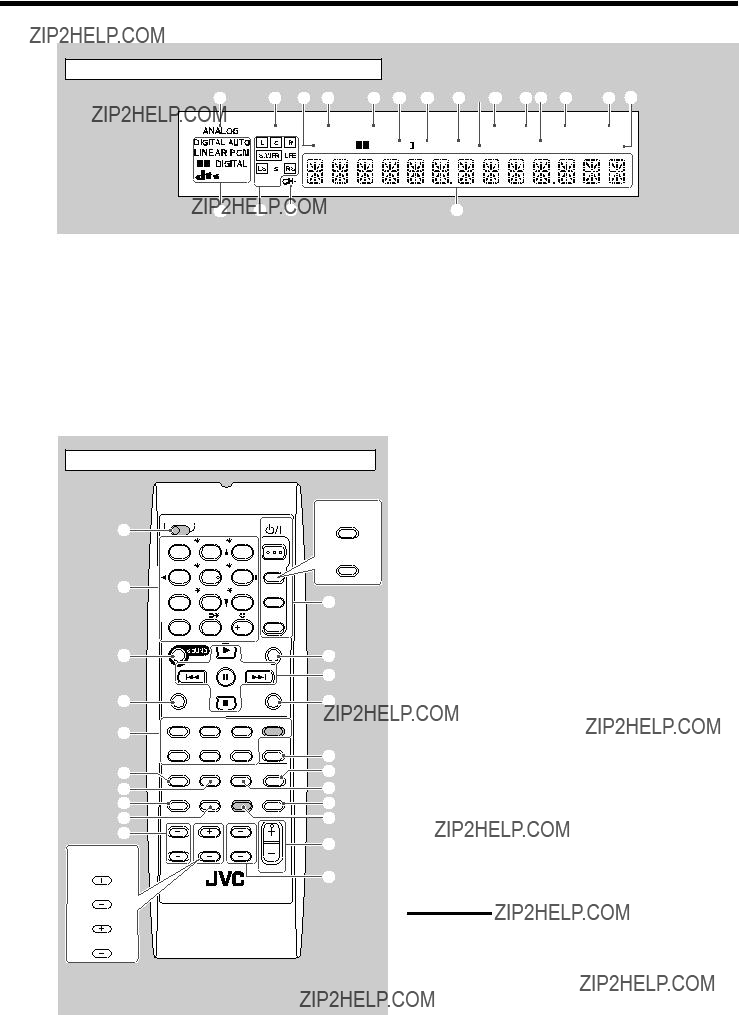
Display
See pages in parentheses for details.
1 ANALOG indicator (14)
2 DUAL MONO indicator (26, 27)
3 H.PHONE indicator (13, 26, 28)
4
5 VIRTUAL SB indicator (22)
6  PRO LOGIC II indicator (25, 27, 28)
PRO LOGIC II indicator (25, 27, 28)
7 DSP indicator (28, 29)
8 DIGITAL EQ indicator (24)
9 Only for
Remote Control
TV CH
The items shaded in the
BASSBOOST buttons, TV/CATV
0 TUNED indicator (16) - STEREO indicator (16) = INPUT ATT indicator (14)
~ AUTO MUTING indicator (17) ! SLEEP indicator (15)
@ VOLUME indicator (11)
# Digital signal format indicators (13)
$ Speaker indicators and signal indicators (12) % CH??? indicator (16)
^ Main display
See pages in parentheses for details.
1 Only for
2 10 keys for selecting preset channels (17, 33)
10 keys for sound adjustment (24, 33)
10 keys for operating audio/video components (33 ??? 35)
3 SOUND button (24, 33)
4 REC PAUSE button (34, 36)
5Source selection buttons (11, 12)
TAPE/CDR, CD, DVD, DVD MULTI (only for
FM/AM, TV SOUND, VCR 6 FM MODE button (17, 33) 7 SURROUND button (27, 33) 8 DIMMER button (14, 33) 9 TV/VIDEO button (34, 35) 0 VCR CH +/??? buttons (34, 36)
-For
For
= STANDBY/ON  buttons (11, 33 ??? 36)
buttons (11, 33 ??? 36)
AUDIO, TV/CATV (or TV for
! Operating buttons for audio/video components 3, 8, 7, ??/4, FF/REW (33, 34, 36)
@
# ANALOG/DIGITAL button (13, 14, 33) $ SURROUND/DSP OFF button (27, 29, 33) % DSP button (28, 29, 33)
^ MUTING button (15, 33)
& Only for
( TV VOLUME +/??? buttons (34, 35)
Note:
When you press the one of the audio source selection buttons??? TAPE/CDR, CD, and
3

Parts Identification
Rear Panel
1 2 3 4 5 6
pq
See pages in parentheses for details.
1DIGITAL IN terminals (10)
???Coaxial: DIGITAL 1 (DVD)
???Optical: DIGITAL 2 (CD)
DIGITAL 3 (TV): only for
2Audio input/output jacks (7 ??? 9)
???Input: CD IN, TAPE/CDR IN (PLAY), VCR IN (PLAY),
TV SOUND IN, DVD IN
???Output: TAPE/CDR OUT (REC), VCR OUT (REC),
SUBWOOFER OUT
3 COMPU
4 For
AV COMPU
AV COMPU LINK jacks (31) 5 ANTENNA terminals (5, 6)
6Only for
COMPONENT VIDEO input/output jacks (8, 9)
p FRONT SPEAKERS terminals (6) q AC power cord (10)
4
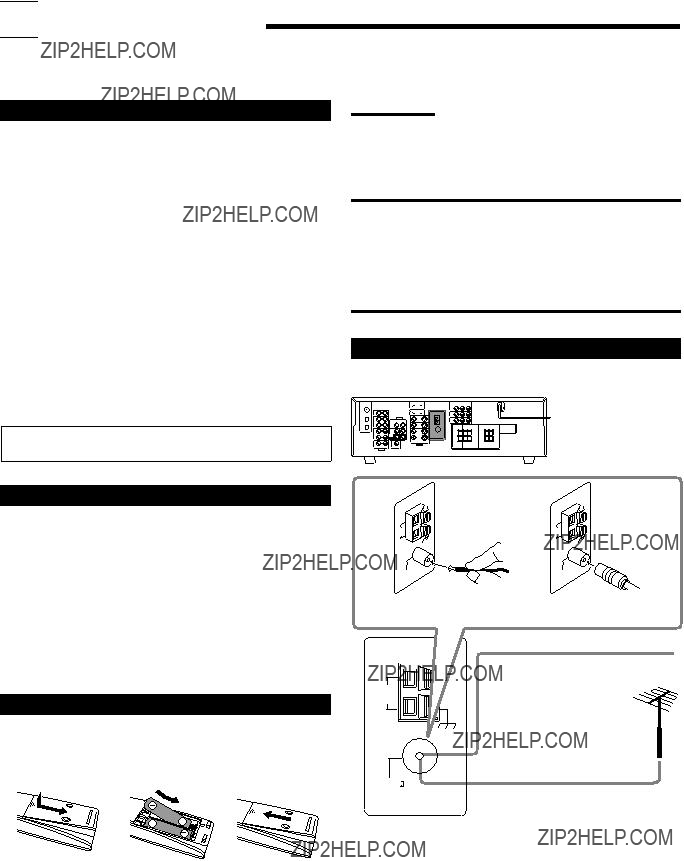

 Getting Started
Getting Started
This section explains how to connect audio/video components and speakers to the receiver, and how to connect the power supply.
Before Installation
General Precautions
???Be sure your hands are dry.
???Turn the power off to all components.
???Read the manuals supplied with the components you are going to connect.
Locations
???Install the receiver in a location that is level and protected from moisture and dust.
???The temperature around the receiver must be between
???Make sure there is good ventilation around the receiver. Poor ventilation could cause overheating and damage the receiver.
Notes:
???Supplied batteries are for the initial setup. Replace for continued use.
???For
CAUTION:
Follow these precautions to avoid leaking or cracking cells:
???Place batteries in the remote control so they match the polarity: (+) to (+) and
???Use the correct type of batteries. Batteries that look similar may differ in voltage.
???Always replace both batteries at the same time.
???Do not expose batteries to heat or flame.
Handling the receiver
???Do not insert any metal object into the receiver.
???Do not disassemble the receiver or remove screws, covers, or cabinet.
???Do not expose the receiver to rain or moisture.
Do not connect the AC power cord until all other connections have been made.
Checking the Supplied Accessories
Check to be sure you have all of the following items, which are supplied with the receiver.
The number in the parentheses indicates quantity of the pieces supplied.
???Remote Control (1)
???Batteries (2)
???AM Loop Antenna (1)
???FM Antenna (1)
If anything is missing, contact your dealer immediately.
Putting Batteries in the Remote Control
Before using the remote control, insert the two supplied batteries first.
1Press and slide the battery cover on the back of the remote control.
2Insert the batteries.
??? Make sure to match the polarity: (+) to (+) and
3Replace the cover.
Connecting the FM and AM Antennas
FM antenna connections
AB
Extend the supplied FM antenna horizontally.
AM
 EXT
EXT
AM
LOOP
FM Antenna (supplied)
Connect the supplied FM antenna as temporary measure to the FM 75 ??? COAXIAL
If reception is poor, connect the outdoor FM antenna (not
1Disconnect the supplied FM antenna.
2Connect a 75 ??? coaxial cable with the standard type connector
(IEC or DIN45325).
If the remote control cannot transmit signals or operate the receiver correctly, replace the batteries. Use two
5

Getting Started
AM antenna connections
Connecting the speakers
For
AM
 EXT
EXT
AM
LOOP
FM 75
COAXIAL
ANTENNA
AM Loop Antenna (supplied)
Snap the tabs on the loop into the slots of the base to assemble the AM loop antenna.
For
For each speaker (except for a subwoofer), connect the (+) and
Outdoor single
Turn the loop until you have the best reception.
Notes:
??? If the AM loop antenna wire is covered with vinyl, remove the vinyl by twisting it as illustrated.
???Make sure the antenna conductors do not touch any other terminals, connecting cords and power cord.
This could cause poor reception.
???If reception is poor, connect an outdoor single
(not supplied) to the AM EXT terminal. (Keep the AM loop antenna connected.)
Connecting the Speakers and Subwoofer
You can connect five speakers (a pair of front speakers, a center speaker, and a pair of surround speakers) and a subwoofer.
CAUTIONS:
???Use only the speakers of the SPEAKER IMPEDANCE indicated by the speaker terminals.
???Do not connect more than one speaker to each speaker terminal.
For
6
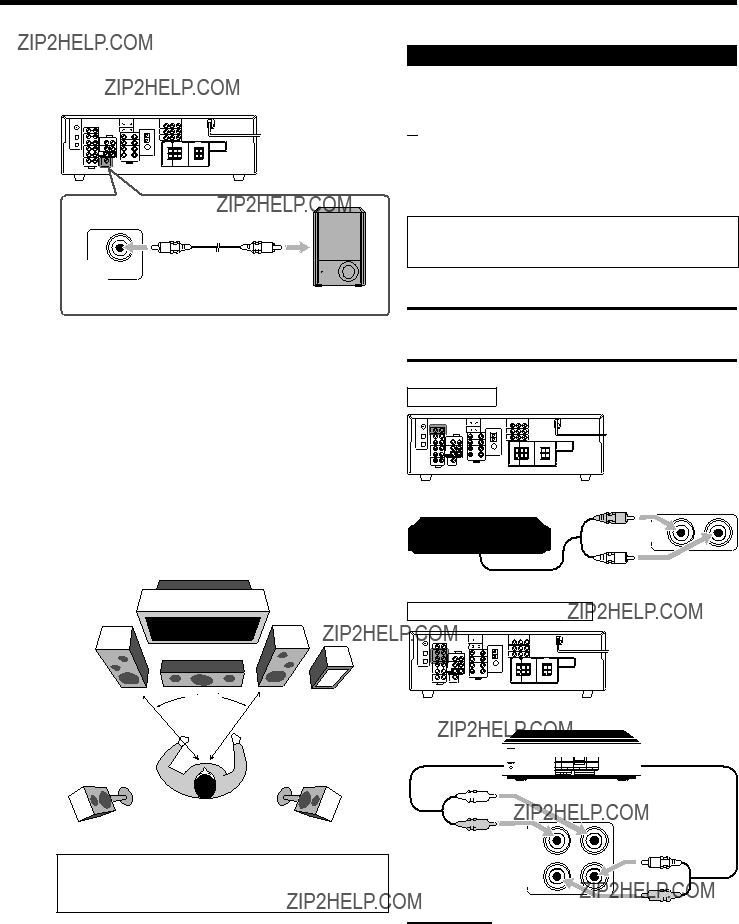
Connecting the subwoofer
You can enhance the bass by connecting a subwoofer.
Connect the input jack of a powered subwoofer to the rear panel, using a cable with RCA pin plugs (not supplied).
Connecting Audio/Video Components
When connecting individual components, refer also to the manuals supplied with them.
SUBWOOFER
OUT
Powered subwoofer
Placing speakers
Front speakers (L/R) and center speaker (C)
???Place these speakers at the same height from the floor, at or near ear level.
???Array across the front of the viewing area.
Surround speakers (LS/RS)
???Place these speakers alongside and slightly to the rear of (but not behind) the listening position; well above ear level (60 cm to 90 cm higher).
???Point these speakers directly across the listening area, but not at the listener???s ears.
Subwoofer (S.WFR)
???You can place it wherever you like since bass sound is non- directional. Normally place it in front of you.
After connecting the speakers, set the speaker installation information properly. You can use Quick Speaker Setup for it (see page 18).

 Analog Connections
Analog Connections
Audio component connections
Use the cables with RCA pin plugs (not supplied).
???Connect the white plug to the audio left jack, and the red plug to the audio right jack.
If your audio components have a COMPU LINK jack
See also page 30 for detailed information about the connection and the COMPU LINK remote control system.
CAUTION:
If you connect a
CD player
CD player
Cassette deck or CD recorder
To audio input 

 To audio output
To audio output





 L
L 





 R
R 

OUT (REC)
IN (PLAY)

 R
R 





Note:
When connecting a CD recorder to the TAPE/CDR jacks, change the source name to ???CDR,??? which will be shown on the display when it is selected as the source. See page 14 for details.
7

Getting Started
Video component connections
Use the cables with RCA pin plugs (not supplied).
Connect the white plug to the audio left jack, the red plug to the audio right jack, and the yellow plug to the video jack.
???For
Component video >
However, the video signals from one type of these input jacks are transmitted only through the video output jacks of the same type.
If your video components have an AV COMPU LINK jack
See also page 31 for detailed information about the connection and the AV COMPU LINK remote control system.
VCR
Only for
VCR
?? To
?? To composite video output ?? To composite video input ?? To
??? To component video output ?? To audio output
?? To audio input
TV
MONITOR OUT
Red
Blue
Only for
Green
MONITOR
OUT
TV
B 
C
D
Connect the TV to appropriate MONITOR OUT jacks to view
the playback picture from any other connected video components.
?? To audio output
?? To component video input ?? To
?? To composite video input
8
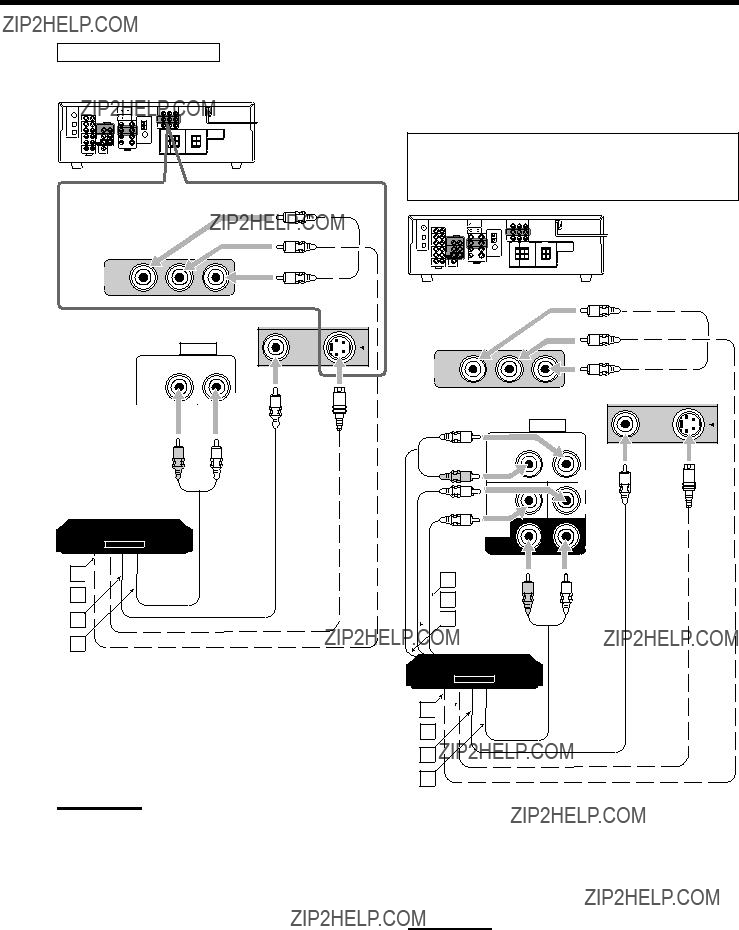
DVD player
??? When you connect a DVD player with stereo output jacks:
Only for
DVD player
DVD
Only for
???When you connect a DVD player with its analog discrete output
This connection is the best connection method for enjoying DVD Audio sounds.
???When a DVD Audio disc is played back, the original high- quality sounds can be reproduced only using this connection.
A 

B
A
B
R L
C
D
?? To component video output ?? To
?? To composite video output
??To left/right front channel audio output (or to
Notes:
???For
IN DVD) correctly for AV COMPU LINK. See page 22 for details.
???To enjoy Dolby Digital and DTS
Dual Mono software), connect the DVD player through the digital input/output terminals.

 C
C
DVD player
DVD
D 
E
F
G
?? To subwoofer output
?? To center channel audio output
?? To left/right front channel audio output ?? To component video output
??? To
?? To composite video output
?? To left/right surround channel audio output
Note:
When connecting a DVD player to the component video input jacks, make the component video input setting (VIDEO IN DVD) correctly for AV COMPU LINK. See page 22 for details.
9
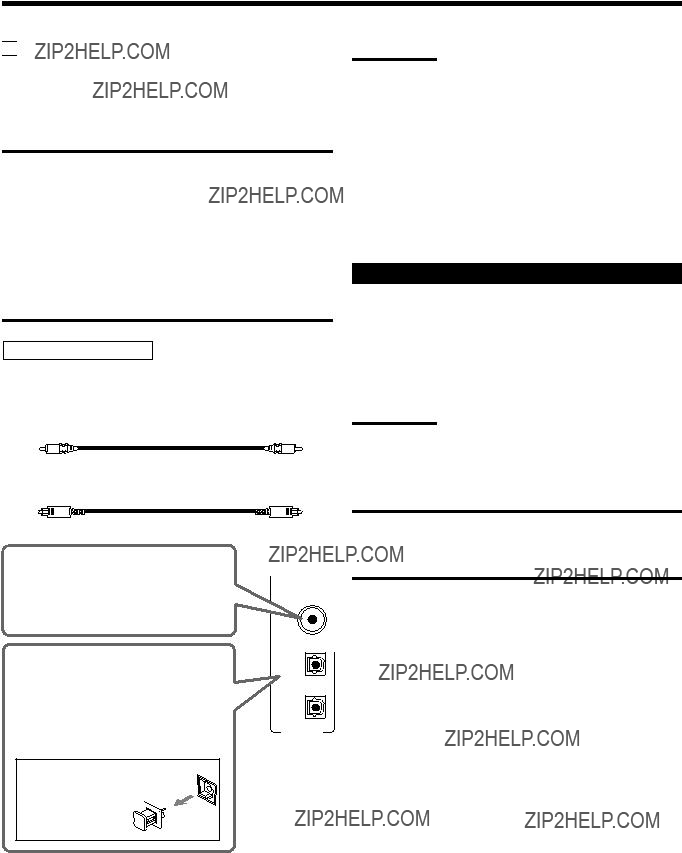
Getting Started

 Digital Connections
Digital Connections
By connecting the receiver and the source component through the digital terminals, sound reproduction quality will be much improved. In addition, you can enjoy
IMPORTANT:
???When connecting a video component using the digital terminals, you also need to connect it to the video jacks on the rear. Without connecting it to the video jacks, you can view no playback picture.
???After connecting the components using the DIGITAL IN terminals, set the following correctly if necessary.
???Set the digital input (DIGITAL IN) terminal setting correctly. For details, see ???Setting the Digital Input Terminals??? on page 22.
???Select the digital input mode correctly. For details, see ???Selecting the Analog or Digital Input Mode??? on page 13.
Digital input terminals
You can connect any digital components having coaxial or optical digital output terminal.
Notes:
???When shipped from the factory, the DIGITAL IN terminals have been set for use with the following components:
???DIGITAL 1 (coaxial): For DVD player
???DIGITAL 2 (optical): For CD player
Only for
??? DIGITAL 3 (optical): For digital TV broadcast tuner
???When you want to operate the CD player or CD recorder using the
COMPU LINK remote control system (see page 30), connect it also as described in ???Analog Connections??? (see page 7).
???When you want to operate a DVD player or TV using the AV
COMPU LINK remote control system (see page 31), connect it also as described in ???Video component connections??? of ???Analog Connections??? (see pages 8 and 9).
Connecting the Power Cord
Before plugging the receiver into an AC outlet, make sure that all connections have been made.
Plug the power cord into an AC outlet.
???Keep the power cord away from the connecting cables and the antenna. The power cord may cause noise or screen interference.
Digital coaxial cable (not supplied) between digital coaxial terminals
Digital optical cable (not supplied) between digital optical terminals
When the component has a digital coaxial output terminal, connect it to the DIGITAL 1 (DVD) terminal, using a digital coaxial cable (not supplied).
When the component has a digital optical output terminal, connect it to the DIGITAL 2
Before connecting a digital optical cable, unplug the protective plug. 
DIGITAL 1 (DVD)
DIGITAL 2 (CD)
DIGITAL 3 (TV)
DIGITAL IN
Note:
The preset settings such as preset channels and sound adjustment may be erased in a few days in the following cases:
???When you unplug the power cord.
???When a power failure occurs.
CAUTIONS:
???Do not touch the power cord with wet hands.
???Do not pull on the power cord to unplug the cord. When unplugging the cord, always grasp the plug so as not to damage the cord.
10
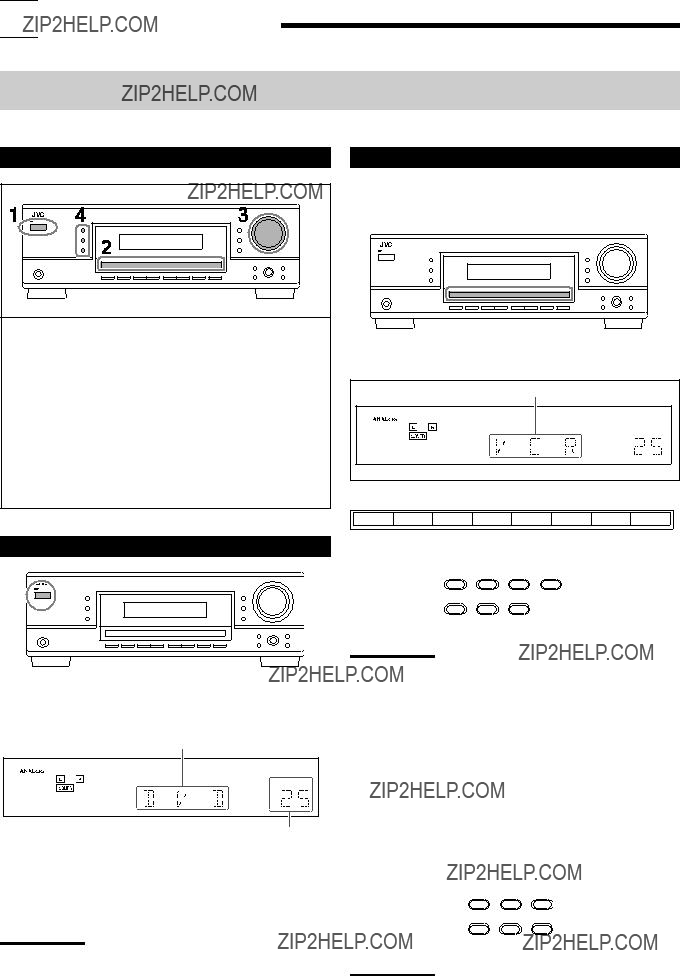

 Basic Operations
Basic Operations
The following operations are commonly used when you play any sound sources.
Operations hereafter will be explained using the buttons on the front panel.
You can also use the buttons on the remote control for the same functions if they have the same and similar names/marks.
1Turn on the power.
???See ???Turning On the Power??? below.
2Select the source.
???See ???Selecting the Source to Play??? to the right.
3Adjust the volume.
???See ???Adjusting the Volume??? on page 12.
4Select the Surround or DSP modes.
???See ???Activating the Surround Modes??? (page 27) and ???Activating the DSP Modes??? (page 29).
Turning On the Power
Press STANDBY/ON  (or STANDBY/ON
(or STANDBY/ON  AUDIO on the remote control).
AUDIO on the remote control).
The STANDBY lamp goes off.
Current source name appears.
VOLUME
Current volume level appears.
To turn off the power (into standby mode),
press STANDBY/ON  (or STANDBY/ON
(or STANDBY/ON  AUDIO on the remote control) again.
AUDIO on the remote control) again.
The STANDBY lamp lights up.
Note:
A small amount of power is consumed in standby mode. To turn off
the power completely, unplug the AC power cord.
When you have connected digital source components using the digital terminals, first change the input mode for these components to the digital input mode (see page 13).
Press one of the source selection buttons.
Selected source name appears.
VOLUME
For
On the remote
Note:
When you select ???DVD MULTI,??? you can enjoy analog discrete output sound
???You may need to select analog discrete output mode on the external component.
???When using the headphones, you can listen to the front channel sounds (left and right) only.
???Surround and DSP modes (see pages 25 and 28) cannot be applied to ???DVD MULTI.???
For
SOURCE NAME
On the front panel
TAPE/CDR CD DVD
FM/AM TV SOUND VCR
On the remote
Note:
When connecting a CD recorder to the TAPE/CDR jacks, change the source name shown on the display. For details, see page 14.
11
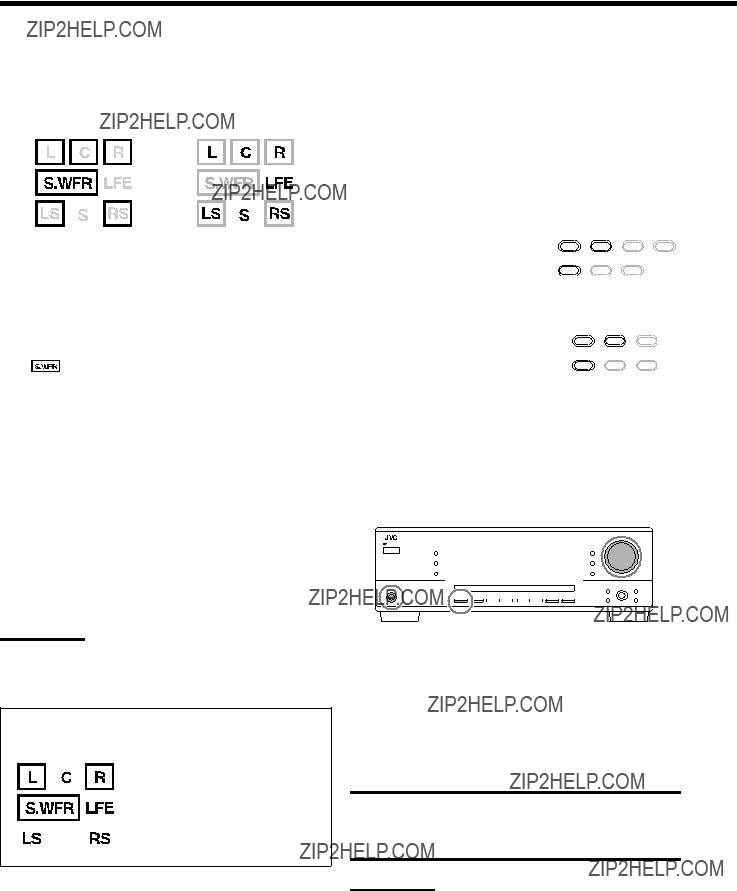
Basic Operations
Note:
For
???R,??? ???LFE,??? ???LS,??? and ???RS??? light up.
How to understand the speaker and signal indicator illumination
Ex. No sound comes out of the center speaker and surround speakers though center channel and surround channel signals are coming into this receiver.
On the front panel:
To increase the volume, turn MASTER VOLUME clockwise. To decrease the volume, turn it counterclockwise.
On the remote control:
To increase the volume, press VOLUME +.
To decrease the volume, press VOLUME
CAUTION:
Always set the volume to the minimum before starting any sources. If the volume is set at its high level, the sudden blast of sound energy can permanently damage your hearing and/ or ruin your speakers.
Note:
The volume level can be adjusted within the range of ???0??? (minimum) to
???50??? (maximum).
12

Listening with headphones:
You can enjoy not only stereo software but also multi- channel software through the headphones. (Sounds are
1Press SPEAKERS ON/OFF to deactivate the speakers.
???HEADPHONE??? appears for a while, and the H.PHONE indicator lights on the display.
???If the Surround or DSP mode has been activated, ???3D H PHONE??? appears for a while (and the DSP indicator also lights up on the
2Connect the headphones to the PHONES jack on the front panel.
???If you do not deactivate the speakers, no sound comes out of the headphones.
After using the headphones, disconnect the headphones, then press SPEAKERS ON/OFF again to activate the speakers.
CAUTION:
Be sure to turn down the volume....
???Before connecting or putting on headphones, as its high volume can damage both the headphones and your hearing.
???Before turning on speakers again, as its high volume may come out of the speakers.
You can cancel the subwoofer output even though you have connected a subwoofer and have set ???SUBWOOFER??? to ???SUBWOOFER YES??? (see page 20).
Press SUBWOOFER OUT ON/OFF to cancel the subwoofer output.
Each time you press the button, subwoofer output is deactivated (???SUBWOOFER OFF???) and activated (???SUBWOOFER ON???) alternately.
??? When subwoofer output is canceled, the indicator goes off. Bass sounds (and LFE signals) will be emitted through the front speakers.
Notes:
???When subwoofer output is activated, you can also adjust the subwoofer output level. For details, see page 24.
???You cannot deactivate the subwoofer output when you set ???SMALL??? for the front speakers on the speaker size setting (see page 20) or using Quick Speaker Setup (see page 18).
???You cannot activate the subwoofer output when you have set ???SUBWOOFER??? to ???SUBWOOFER NO??? (see page 20).
???When you change the ???SUBWOOFER??? setting from ???SUBWOOFER NO??? to ???SUBWOOFER YES??? (see page 20), subwoofer output is automatically activated.
Selecting the Analog or Digital Input Mode
When you have connected digital source components using the both analog and digital terminals (see pages 7 to 10), you can select the input
Before you start, remember...
The digital input terminal setting should be correctly done for the sources you want to select the digital input mode (see ???Setting the Digital Input Terminals??? on page 22).
1Press one of the source selection buttons (DVD,
TV SOUND, CD, TAPE/CDR*) for which you want to change the input mode.
*If ???TAPE??? is selected as the source, digital input mode is not available. To change the source name, see ???Changing the Source Name??? on page 14.
2Press INPUT DIGITAL to select ???DIGITAL AUTO.???
The DIGITAL AUTO indicator lights up on the display.
???When using the remote control, press ANALOG/DIGITAL. Each time you press the button, the analog (ANALOG) and digital (DIGITAL AUTO) input modes alternate.
???When selecting ???DIGITAL AUTO,??? the following indicators indicate the digital signal format of the incoming signal.
: Lights up when Linear PCM signals come in.
: Lights up when Dolby Digital signals come in.
: Lights up when conventional DTS signals come in.
: Lights up when DTS 96/24 signals come in.
No indicator lights up when the receiver cannot recognize the digital signal format of the incoming signals.
Note:
For details about the digital signal formats, see pages 25 and 26.
Continued on the next page
13

Basic Operations
When playing software encoded with Dolby Digital or DTS, the following symptoms may occur:
???Sound does not come out at the beginning of playback.
???Noise comes out while searching for or skipping chapters or tracks.
???Each time you press INPUT DIGITAL, the input mode changes as follows:
When the input level of the analog source is too high, the sounds will be distorted. If this happens, you need to attenuate the input signal level to prevent the sound distortion.
???Once you have made adjustment, it is memorized for each analog source.
 DIGITAL AUTO
DIGITAL AUTO  DOLBY DIGITAL
DOLBY DIGITAL
DTS SURROUND 
When ???DOLBY DIGITAL??? or ???DTS SURROUND??? is selected,
the DIGITAL AUTO indicator goes off, and the corresponding digital signal format indicator lights up on the display.
???If the incoming signal does not match the selected digital signal format, the indicator of the selected signal format will flash.
Note:
When you turn off the power or select another source, ???DOLBY DIGITAL??? and ???DTS SURROUND??? settings are canceled and the digital input mode is automatically reset to ???DIGITAL AUTO.???
To select the analog input mode
Press INPUT ANALOG (or ANALOG/DIGITAL on the remote control repeatedly until ???ANALOG??? appears on the display). The ANALOG indicator lights up.
Changing the Display Brightness
You can dim the display.
Press DIMMER.
???Each time you press the button, the display dims and brightens alternately.
Press and hold INPUT ATT (INPUT ANALOG) so that the INPUT ATT indicator lights up on the display.
???Each time you press and hold the button, the input attenuator mode turns on (???INPUT ATT ON???) and off (???INPUT NORMAL???).
Note:
For
selected.
When you have connected a CD recorder to the TAPE/CDR jacks on the rear panel, change the source name which will be shown on the display.
When changing the source name from ???TAPE??? to ???CDR???:
1Press TAPE/CDR (SOURCE NAME).
??? Make sure ???TAPE??? appears on the display.
2Press and hold SOURCE NAME (TAPE/CDR) until ???ASSIGN CDR??? appears on the display.
To change the source name back to ???TAPE,??? repeat the same
procedure above.
Note:
Without changing the source name, you can still use the connected components. However, there may be some inconvenience.
??????TAPE??? will appear on the display when you select the CD recorder.
???You cannot use the digital input (see page 13) for the CD recorder.
14

The following basic operations are possible only using the remote control.
Using the Sleep Timer
Using the Sleep Timer, you can fall asleep while listening to music. When the
TA/NEWS/INFO
BASSBOOST MUTING
Muting the Sound
Reinforcing the Bass (Only for
Press SLEEP repeatedly.
The SLEEP indicator lights up on the display, and the
OFF (Canceled)
To check or change the time remaining until the
Press SLEEP once.
The remaining time until the
??? To change the
To cancel the Sleep Timer:
Press SLEEP repeatedly until ???SLEEP OFF??? appears on the display. The SLEEP indicator goes off.
??? Turning off the power also cancels the Sleep Timer.
Reinforcing the Bass
This function is only for
You can boost the bass level.
??? Once you have made adjustment, it is memorized for each source.
Press BASSBOOST to boost the bass level.
The BASS BOOST indicator lights up on the display.
???Each time you press the button, Bass Boost turns on (???BASSBOOST ON???) and off (???BASSBOOST OFF???) alternately.
Note:
This function affects only the sounds from the front speakers.
Muting the Sound
Press MUTING to mute the sound through all speakers and headphones connected.
???MUTING??? appears on the display and the volume turns off (the VOLUME indicator and its level indication go off).
To restore the sound, press MUTING again.
???Turning MASTER VOLUME on the front panel or pressing VOLUME +/??? on the remote control also restores the sound.
Recording a source
You can record any sources playing through the receiver to a cassette deck (or a CD recorder) connected to the TAPE/CDR jacks and the VCR connected to the VCR jacks at the same time.
While recording, you can listen to the selected sound source at whatever sound level you like without affecting the sound levels of the recording.
Note:
The output volume level, Midnight Mode (see page 21), Bass Boost (only for
Surround modes and DSP modes (see pages 25 to 29) cannot affect the recording.
Basic adjustment auto memory
This receiver memorizes sound settings for each source???
???when you turn off the power,
???when you change the source,
???when you change the analog/digital input modes, and
???when you assign the source name (see page 14).
When you change the source, the memorized settings for the newly selected source are automatically recalled.
The following can be stored for each source:
???Analog/digital input mode (see page 13)
???Input attenuator mode (see page 14)
???Equalization pattern (see page 24)
???Speaker output levels (see page 24)
???Surround and DSP mode selection (see pages 25 and 28)
???Bass Boost setting (only for
Notes:
???If the source is FM or AM, you can assign a different setting for each band.
???A sound setting assigned for a digital component is valid for both the analog and digital input modes.
15


 Receiving Radio Broadcasts
Receiving Radio Broadcasts
You can browse through all the stations or use the preset function to go immediately to a particular station.
Tuning in to Stations Manually

 Remote
Remote
NOT
Using Preset Tuning
1Select the band (FM or AM).
???For
???For
Each time you press the button, the band alternates between FM and AM.
AUTO MUTING
VOLUME
TUNED STEREO AUTO MUTING
VOLUME
The last received station of the selected band is tuned in.
2Press FM/AM TUNING 5 or ??? repeatedly until you find the frequency you want.
???Pressing FM/AM TUNING 5 increases the frequency.
???Pressing FM/AM TUNING ??? decreases the frequency.
Once a station is assigned to a channel number, the station can be quickly tuned in. You can preset up to 30 FM and 15 AM stations.
Before you start, remember...
There is a time limit in doing the following steps. If the setting is canceled before you finish, start from step 2 again.
1Tune in the station you want to preset (see ???Tuning in to Stations Manually???).
???If you want to store the FM reception mode for this station, select the FM reception mode you want. See ???Selecting the FM Reception Mode??? on page 17.
2Press MEMORY.
TUNED STEREO AUTO MUTING
VOLUME
The channel number position starts flashing on the display for about 5 seconds.
TUNED STEREO AUTO MUTING
VOLUME
Notes:
???When a station of sufficient signal strength is tuned in, the TUNED indicator lights up on the display.
???When an FM stereo program is received, the STEREO indicator also lights up.
???When you hold and then release the button in step 2, the frequency keeps changing until a station is tuned in.
3Press FM/AM PRESET 5 or ??? to select a channel number while the channel number position is flashing.
TUNED STEREO AUTO MUTING
VOLUME
4 Press MEMORY again while the selected channel number is flashing on the display.
The selected channel number stops flashing.
The station is assigned to the selected channel number.
5Repeat steps 1 to 4 until you store all the stations you want.
To erase a stored preset station
Storing a new station on a used number erases the previously stored one.
16
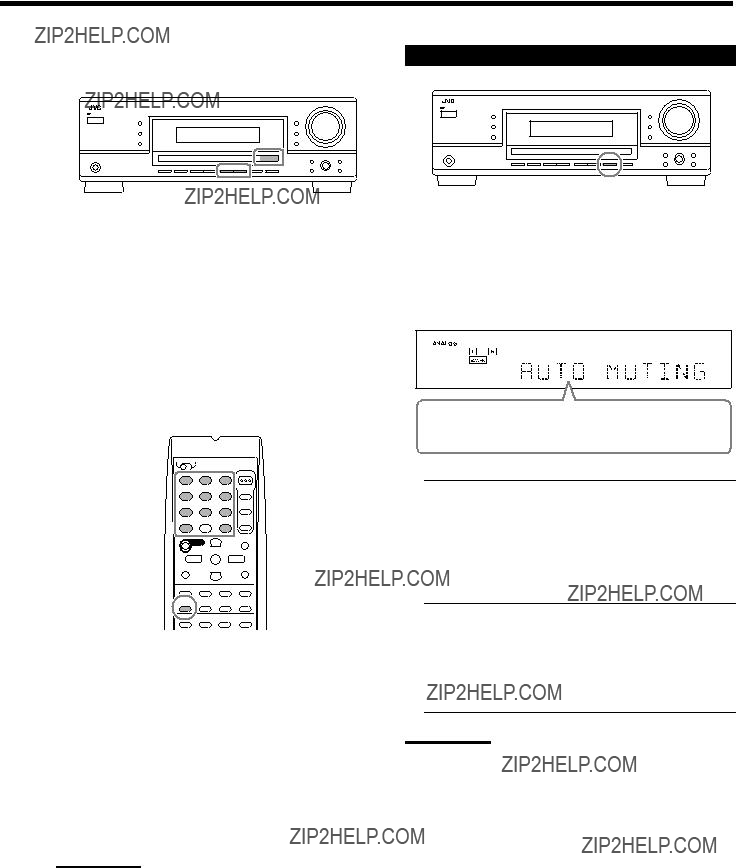
To tune in a preset station
On the front panel:
1Select the band (FM or AM).
???For
???For
Each time you press the button, the band alternates between FM and AM.
2Press FM/AM PRESET 5 or ??? until you find the channel you want.
???Pressing FM/AM PRESET 5 increases the number.
???Pressing FM/AM PRESET ??? decreases the number.
On the remote control:
TA/NEWS/INFO
1 Press FM/AM to select the band.
The last received station of the selected band is tuned in.
???Each time you press the button, the band alternates between FM and AM.
2Press the 10 keys to select a preset channel number.
???For channel number 5, press 5.
???For channel number 15, press +10 then 5.
???For channel number 20, press +10 then 10.
???For channel number 30, press +10, +10, then 10.
Note:
When you use the 10 keys on the remote control, be sure that they are activated for the tuner, not for the CD and others. (See page 33.)
Selecting the FM Reception Mode
When an FM stereo broadcast is hard to receive or noisy, you can change the FM reception mode while receiving an FM broadcast.
???You can store the FM reception mode for each preset station (see page 16).
While listening to an FM station, press FM MODE.
???Each time you press the button, the FM reception mode alternates between ???AUTO MUTING??? and ???MODE MONO.???
TUNED STEREO AUTO MUTING
AUTO MUTING 
 MODE MONO
MODE MONO
AUTO MUTING: Normally select this.
When a program is broadcasted in stereo, you will hear stereo sound; when in monaural, you will hear monaural sounds. This mode is also useful to suppress static noise between stations.
The AUTO MUTING indicator lights up on the display. (Initial setting)
MODE MONO: Select this to improve the reception (but stereo effect will be lost).
In this mode, you will hear noise while tuning in to the stations.
The AUTO MUTING indicator goes off from the display (the STEREO indicator goes off).
Note:
After you operate any source other than the tuner using the remote control, the FM MODE button on the remote control does not work.
In this case, press FM/AM on the remote control, then press FM
MODE.
17


 Basic Settings
Basic Settings
Some of the following settings are required after connecting and positioning your speakers while others will make operations easier. You can use QUICK SPEAKER SETUP to easily set up your speaker configuration.
Quick Speaker Setup helps you to easily and quickly register the speaker size and speaker distance according to your listening room to create the best possible surround effect.
???You can also register each speaker???s information manually. For details, see page 20.
Before you start, remember...
There is a time limit in doing the following steps. If the setting is canceled before you finish, start from step 1 again.
1 Press QUICK SPEAKER SETUP.
???SPK=??? and the initial speaker channel number (5.0CH) appears.
2Turn MULTI JOG to select an appropriate number of the connected speakers (speaker
channel number).
As you turn the jog, the speaker channel number changes as follows.
???For the details of speaker channel number, see ???Speaker channel number and the size.???
5.0CH ??? 5.1CH ??? 2.0CH ??? 2.1CH ??? 3.0CH ??? 3.1CH ??? 4.0CH ??? 4.1CH ??? (Back to the beginning)
3 Press in MULTI JOG (PUSH SET).
???ROOM SIZE=??? and the initial room size setting appear.
4 Turn MULTI JOG to select an appropriate room size to match to your listening room.
As you turn the jog, the room size changes as follows.
???To select your appropriate room size, see ???Room size and the speaker distance.???
 L (Large)
L (Large) 
 S (Small)
S (Small) 
 M (Medium)
M (Medium)
5 Press in MULTI JOG (PUSH SET).
???COMPLETE??? appears on the display, then goes back to the source indication.
Notes:
???This procedure will not be completed if you stop in the middle of the setting process.
???Once Quick Speaker Setup is performed, the speaker output levels are also set to appropriate values automatically (common to all sources). If you want to set the speaker output levels separately for each source, see ???Adjusting the Speaker Output Levels??? on page 24.
Speaker channel number and the size
You can find how each of the speaker size is defined according to the number of connected speakers (speaker channel ???CH??? number) you select.
??? Subwoofer (S.WFR) is counted as 0.1 channel.
Room size and the speaker distance
According to the selected room size, speaker distance for each activated speaker is set as follows:
Note:
In the tables above, ???L??? stands for the left front speaker, ???R??? for the right front speaker, ???C??? for the center speaker, ???LS??? for the left surround speaker, ???RS??? for the right surround speaker, and ???S.WFR??? for the subwoofer.
18

Basic Setting Items
On the following pages, you can adjust the following items:
???You can only select the items currently available. For details, see the explanation of each item.
Notes:
*1 These items can be set using Quick Speaker Setup.
*2 This setting is only for
Before you start, remember...
There is a time limit in doing the following steps. If the setting is canceled before you finish, start from step 1 again.
Ex. When setting Auto Surround to ???AUTO SURR ON.???
1 Press SETTING.
The last selected item appears on the display.
2Turn MULTI JOG until an item you want appears on the display.
???In this example, select ???AUTO SURROUND.??? For available items, see the list ???Basic Setting Items.???
3Press in MULTI JOG (PUSH SET).
The current setting for the selected item appears on the display.
4Turn MULTI JOG until a setting you want appears on the display.
5Press in MULTI JOG (PUSH SET).
6Repeat steps 2 to 5 to set other items if necessary.
7Press EXIT.
The source indication resumes on the display.
19

Basic Settings

 Setting the Speakers
Setting the Speakers
To obtain the best possible surround effect from the Surround and DSP modes, register the setting about the speaker arrangement after all connections are completed.
???If you have used Quick Speaker Setup on page 18, this setting is not required.
??Subwoofer
Select whether you have connected a subwoofer or not.
SUBWOOFER YES: Select when a subwoofer is connected.
SUBWOOFER NO: Select when no subwoofer is used.
Note:
If you have selected ???SUBWOOFER NO??? for the subwoofer, you cannot use the SUBWOOFER OUT ON/OFF button on the front panel.
??Speaker
SURR SPEAKERS
Select the size for each connected speaker.
LARGE: Select when the speaker size is relatively large.
SMALL: Select when the speaker size is relatively small.
NONE: Select this when you have not connected a speaker. (Not selectable for the front speakers)
Notes:
???Keep the following comments in mind as reference when adjusting.
???If the size of the cone speaker unit built in your speaker is larger than 12 cm, select ???LARGE,??? and if it is smaller than 12 cm, select ???SMALL.???
???If you have selected ???SUBWOOFER NO??? for the subwoofer setting, you can only select ???LARGE??? for the front speakers.
???If you have selected ???SMALL??? for the front speakers, you cannot select ???LARGE??? for the center and surround speakers.

 Setting the Speaker Distance
Setting the Speaker Distance
The distance from your listening point to the speakers is another important element to obtain the best possible sound of the Surround and DSP modes. Set the distance from your listening point to the speakers.
By referring to the speaker distance setting, this unit automatically sets the delay time of the sound through each speaker so that sounds through all the speakers can reach you with the same timing.
???If you have used Quick Speaker Setup on page 18, this setting is not required.
??Measuring
Select which measuring unit you use.
UNIT METER: Select to set the distance in meters.
UNIT FEET: Select to set the distance in feet.
??Speaker
CENTER DIST, SURR L DIST, SURR R DIST
Set the distance from the listening point within the range of
0.3 m (1 ft) to 9.0 m (30 ft), in 0.3 m (1 ft) intervals.
???When shipped from the factory, distance for each speaker is set to ???3.0m (10FT).???
Notes:
???You cannot set the speaker distance for the speakers you have selected ???NONE.???
???For
C
3.3 m
(11 ft)
3.0 m
(10 ft)
Ex. In the above case, set the speaker distance as follows:

 Setting the Bass Sounds
Setting the Bass Sounds
You can adjust subwoofer and bass sounds precisely according to your preference.
??Subwoofer
You can select the type of the signal which can be transmitted through the subwoofer. In other words, you can determine whether or not the bass elements of the front speaker channels are transmitted through the subwoofer regardless of the front speaker size setting (either ???SMALL??? or ???LARGE???).
Select one of the following:
SWFR LFE: Select to emit only the LFE signals (while playing Dolby Digital and DTS software) or the bass elements of the ???SMALL??? front speakers (while playing any source other than the above).
SWFR LFE+MAIN: Select to always emit the bass elements of the front speaker channels (MAIN). While playing Dolby Digital and DTS software, the bass element and the LFE signals are both emitted.
Note:
If you have selected ???SUBWOOFER NO??? for the subwoofer, this function is not available.
20

??Crossover
You can select the crossover frequency for the small speakers used. The signals below the preset frequency level will be sent to and be reproduced by the subwoofer (or by ???LARGE??? speakers when ???SUBWOOFER??? is set to ???SUBWOOFER NO???).
Select one of the crossover frequency levels according to the size of the small speaker connected.
CROSS 80HZ: Select when the cone speaker unit built in the speaker is about 12 cm.
CROSS 100HZ: Select when the cone speaker unit built in the speaker is about 10 cm.
CROSS 120HZ: Select when the cone speaker unit built in the speaker is about 8 cm.
CROSS 150HZ: Select when the cone speaker unit built in the speaker is about 6 cm.
CROSS 200HZ: Select when the cone speaker unit built in the speaker is about 5 cm.
Notes:
???If you have selected ???LARGE??? for all activated speakers (see page 20), this function is fixed to ???CROSS OFF.???
???Crossover frequency is not valid for ???HEADPHONE,??? ???3D H PHONE???
(and ???DVD MULTI??? for
??Low frequency effect
If the bass sound is distorted while playing back software encoded with Dolby Digital or DTS, set the LFE level to eliminate distortion.
??? This function takes effect only when the LFE signals come in.
Select one of the following:
LFE ATT 0dB: Normally select this.
LFE ATT ???10dB: Select when the bass sound is distorted.

 Selecting the Main or Sub Channel
Selecting the Main or Sub Channel
You can select the playback sound (channel) you want while playing digital software recorded (or broadcast) in Dual Mono mode (see page 26), which includes two monaural channels separately.
??Dual
Select the playback sounds (channel).
MONO MAIN: Select to play back the main channel (Ch 1).* Signal indicator ???L??? lights up while playing back this channel.
MONO SUB: Select to play back the
MONO ALL: Select to play back both the main and sub- channels (Ch 1/Ch 2).*
Signal indicators ???L??? and ???R??? light up while playing back these channels.
Notes:
???The Dual Mono format is not identical with bilingual broadcasting or the MTS (Multichannel Television Sound) format used for TV programs. So this setting does not take effect while watching
bilingual or MTS programs.
*Dual Mono signals can be heard from the following
??Midnight
You can enjoy a powerful sound at night using Midnight Mode.
Select one of the following:
MIDNIGHT 1: Select when you want to reduce the dynamic range a little.
MIDNIGHT 2: Select when you want to apply the compress effect fully (useful at midnight).
MIDNIGHT OFF: Select when you want to enjoy playback with its full dynamic range (no effect applied).
Note:
For

 Setting for Easy and Effective Surround Operations
Setting for Easy and Effective Surround Operations
??Auto
Auto Surround works when the unit detects the incoming digital signal. In other words, it works...
???When you select the digital source (the source with digital input selected for it), and
???When you change the input mode from analog to digital.
Select ???AUTO SURR ON??? to activate Auto Surround.
AUTO SURR ON:
???When
???When Dolby Digital
???When Dolby Digital
???When Linear PCM signal is detected, nothing will change.
AUTO SURR OFF: Select to deactivate Auto Surround.
Continued on the next page
21

Basic Settings
Notes:
???This function does not take effect in the following cases:
???While playing an analog source,
???While selecting any of DSP modes (see page 28), or one of the fixed digital input
SURROUND??? (see page 14), and
???While listening with the
???3D H PHONE??? (see pages 13 and 26).
???If you select another Surround mode or DSP mode (or deactivate the Surround/DSP mode) manually, Auto Surround, if in use, will be canceled temporarily for the currently selected source.
Auto Surround setting will be restored in the following cases:
???When you turn the receiver off and on,
???When you change the source,
???When you change the analog/digital input, and
???When you select ???AUTO SURR ON??? again.
??Virtual Surround
You can enjoy the surround back channel while playing back Dolby Digital EX software or
Select ???VRTL SB ON??? to activate Virtual Surround Back.
VRTL SB ON: While you play Dolby Digital EX software or
VRTL SB OFF: Select to deactivate Virtual Surround Back.
Notes:
???When you have set ???NONE??? for ???SURR SPEAKERS,??? this function is not available.
???While playing back
96/24 processing will not be performed with Virtual Surround Back activated. To apply the processing, deactivate Virtual Surround Back.
???Virtual Surroud Back may not be applied to some software.

 Setting the Digital Input Terminals
Setting the Digital Input Terminals
When you use the digital input terminals, register which components you have connected to the digital input terminals.
?? Digital Input
Set the components connected to the digital terminals.
???As you rotate MULTI JOG, the digital input terminals are set to used for the following digital components:
For

 Setting the Component Video Input
Setting the Component Video Input
This setting is only for
When you use the component video inputs for connecting the DVD player and/or VCR, register the type of input jacks.
If you have not selected appropriate video input jacks, the AV COMPU LINK remote control system cannot operate properly. (See page 31.)
??For the DVD
Select one of the following:
DVD COMPONENT: Select when connecting the DVD player to the component video input jacks.
DVD S/C: Select when connecting the DVD player to the composite video or
??For the
Select one of the following:
VCR COMPONENT: Select when connecting the VCR to the component video input jacks.
VCR S/C: Select when connecting the VCR to the composite video or
22
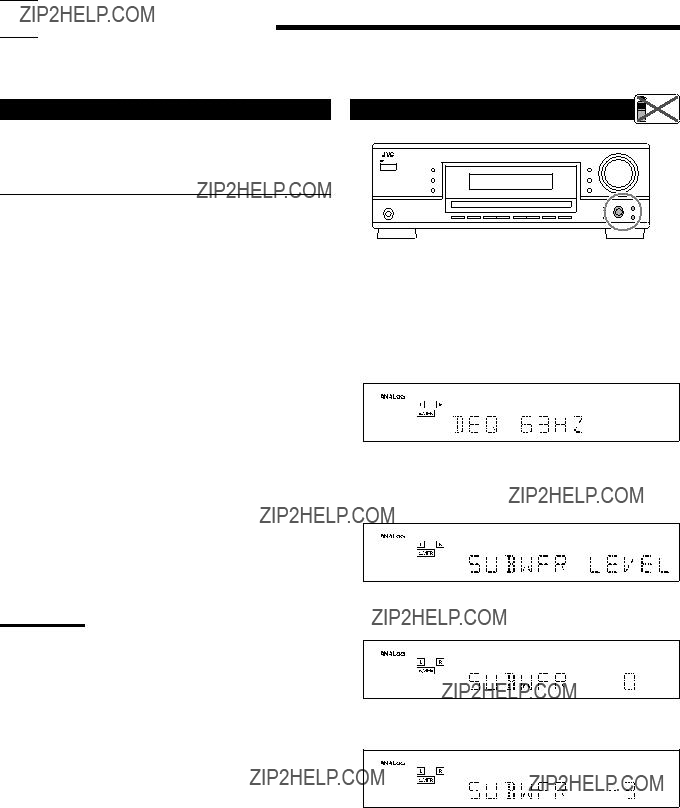

 Adjusting Sound
Adjusting Sound
You can make sound adjustment to your preference after completing basic settings.
Basic Adjustment Items
On the following pages, you can adjust the following items:
???You can adjust only the items applicable to the current sound mode.
Before you start, remember...
There is a time limit in doing the following steps. If the setting is canceled before you finish, start from step 1 again.
Ex. When adjusting the subwoofer level to
1 Press ADJUST.
The last selected item appears on the display.
2Turn MULTI JOG until an item you want appears on the display.
???In this example, select ???SUBWFR LEVEL.??? For available items, see the list ???Basic Adjustment Items.???
Notes:
*1 Adjustable when one of the DAP modes or Mono Film (see pages 28 and 29) is in use.
*2 This setting is only for
*3 Adjustable when Pro Logic II Music is in use.
3 Press in MULTI JOG (PUSH SET).
The current setting (or level) for the selected item appears on the display.
4Turn MULTI JOG to select a setting you want or to make an adjustment as you like.
5Press in MULTI JOG (PUSH SET).
6Repeat steps 2 to 5 to set other items if necessary.
7Press EXIT.
The source indication resumes on the display.
23
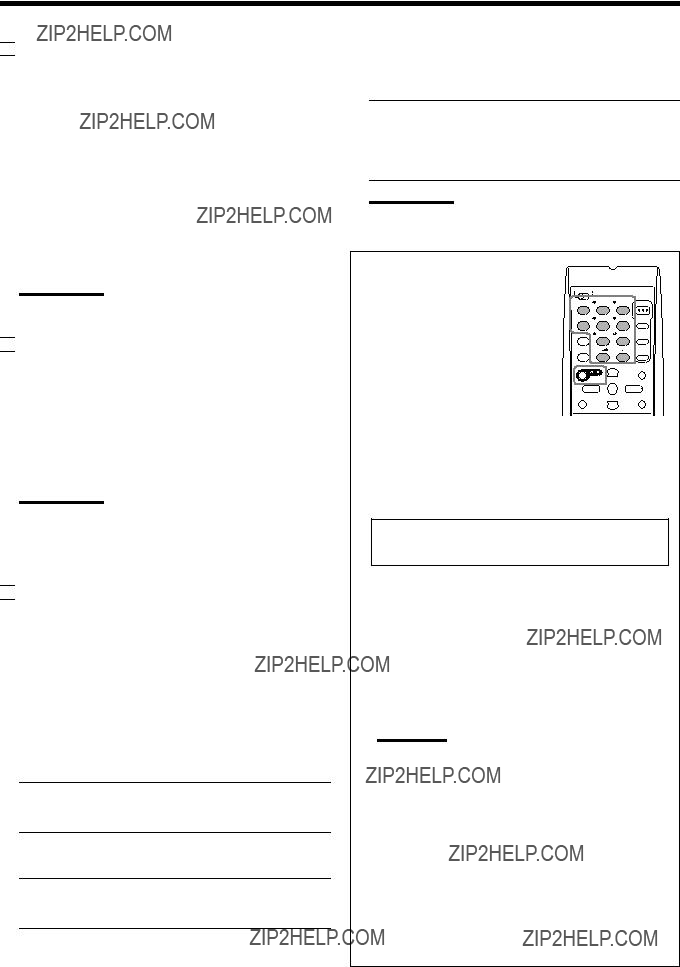
Adjusting Sound

 Adjusting the Equalization Patterns
Adjusting the Equalization Patterns
You can adjust the equalization patterns to your preference.
??? Once you have made adjustment, it is memorized for each source.
??Equalization
You can adjust five frequencies (63 Hz, 250 Hz, 1 kHz,
4 kHz, 16 kHz) within the range of
???When adjustment is made, the DIGITAL EQ indicator lights up on the display.
To flat the equalization pattern, set all the frequencies to
???0 (0 dB)??? in step 4 of ???Basic Procedure??? (on page 23). The DIGITAL EQ indicator goes off from the display.
Only for
For Surround and DSP modes (when the center speaker is connected)
CENTER TONE: Adjust the center tone. As the number increases, the dialogue becomes clearer so that the human voices change from soft to sharp. (Adjustable range: 1 to 5. Normally select ???3.??? )
Note:
This setting is common to all Surround modes, and is memorized separately for DSP modes.
Note:
The equalization patterns affect the front speaker sounds only.

 Adjusting the Speaker Output Levels
Adjusting the Speaker Output Levels
You can adjust the speaker output levels.
??? Once you have made adjustment, it is memorized for each source.
You can also use the remote control for adjusting the speaker output level using the test tone.
???You can also adjust the effect level for DAP modes and Mono Film.
To adjust the speaker output level:
1Press SOUND.
The 10 keys are activated for sound adjustments.
??Adjustable
FRONT L LEVEL, FRONT R LEVEL, CENTER LEVEL,
SURR L LEVEL, SURR R LEVEL
You can adjust the connected speakers??? output levels within the range of
Notes:
???If you have deactivated a speaker (see page 20), the output level adjustment for the speaker is not adjustable.
???For

 Adjusting the Sound Parameters for the Surround and DSP Modes
Adjusting the Sound Parameters for the Surround and DSP Modes
You can adjust the Surround and DSP sound parameters to your preference. (For Surround and DSP modes, see pages 25 and 28.)
???When center speaker is set to ???NONE,??? you cannot adjust the center tone (CENTER TONE).
??Adjustable parameters
You can adjust the following parameters:
For DAP modes and Mono Film
???Once you have made adjustment, it is memorized for each mode.
EFFECT: Adjust the effect level. As the number increases, the effect becomes stronger.
(Adjustable range: 1 to 5. Normally select ???3.??? )
For Pro Logic II Music only
PANORAMA CTRL: Select ???PANORAMA ON??? to add ???wraparound??? sound effect with
??? To cancel it, select ???PANORAMA OFF.???
2Press TEST to check if you can
hear the sounds through all the speakers at equal level.
Test tone (TEST TONE) comes out of the speakers in the following order.
???No test tone comes out of the speakers for which the speaker setting is set to ???NONE??? (or ???SUBWOOFER NO??? for the subwoofer).
L (Left front) = C (Center) = R (Right front) =
RS (Right surround) = LS (Left surround) =
SW (Subwoofer) =(Back to the beginning)
3Adjust the speaker output level
???For the left front speaker: Press FRONT L, then LEVEL
???For the center speaker: Press CENTER, then LEVEL
???For the right front speaker: Press FRONT R, then
LEVEL
???For the right surround speaker: Press SURR R, then LEVEL
???For the left surround speaker: Press SURR L, then LEVEL
???For the subwoofer: Press SUBWFR, then LEVEL
Note:
When you press LEVEL +/??? once, the current level for the selected speaker appears on the display, and the test tone comes out of the selected speaker.
If no adjustment is done for about 4 seconds, the adjustment mode for the selected speaker is canceled.
4 Press TEST again to stop the test tone.
To adjust the effect level:
1Press SOUND.
The 10 keys are activated for sound adjustments.
2Press EFFECT repeatedly to select the effect level (EFFECT 1 to EFFECT 5).
The source indication resumes about 4 seconds after the adjustment.
24


 Using the Surround Modes
Using the Surround Modes
This unit activates a variety of Surround modes automatically. The basic settings and adjustments stored (see pages 18 to 24) are applied automatically.
In a movie theater, many speakers are located on the walls to reproduce impressive
With these many speakers, sound localization and sound movement can be expressed.
Surround modes built in this receiver can create almost the same surround sounds as you can feel in a real movie
Dolby Digital*1
Dolby Digital is a digital signal compression method, developed by Dolby Laboratories, and enables
??? When Dolby Digital signal is detected through the digital input,
Dolby Digital 5.1CH
Dolby Digital 5.1CH (DOLBY DIGITAL) encoding method records and digitally compresses the left front channel, right front channel, center channel, left surround channel, right surround channel, and LFE channel signals (total 6 channels, but the LFE channel is counted as 0.1 channel. Therefore, called 5.1 channel). Dolby Digital enables stereo surround sounds, and sets the cutoff frequency of the surround treble at 20 kHz, compared to 7 kHz for Dolby Pro Logic. As such, the sound movement and
Another digital surround encoding format introduced by Dolby Laboratories is Dolby Digital EX, which adds the third surround channels, called ???surround back.???
Compared to the conventional Dolby Digital 5.1CH, these newly added surround back channels can reproduce more detailed movements behind you while viewing the video software. In addition, surround sound localization will become more stable.
???You can use Virtual Surround Back (see page 22) when playing back Dolby Digital EX software. This function creates the great surround effect from the behind as if you have connected the surround back speakers.
Dolby Pro Logic II
Dolby Pro Logic II is a
???This receiver provides two types of Dolby Pro Logic II modes???
Pro Logic II Movie (PLII MOVIE) and Pro Logic II Music
(PLII MUSIC).
When Dolby Pro Logic II is activated, the  PRO LOGIC
PRO LOGIC  indicator lights up on the display.
indicator lights up on the display.
PLII MOVIE: Suitable for playing any Dolby Surround encoded software. You can enjoy a sound field very close to the one created with discrete 5.1- channel sounds.
PLII MUSIC: Suitable for playing any
*1 Manufactured under license from Dolby Laboratories. ???Dolby???, ???Pro Logic???, and the
Laboratories.
25

Using the Surround Modes
DTS*2
DTS is another digital signal compression method, developed by Digital Theater Systems, Inc., and enables
???When DTS signal is detected through the digital input, the indicator lights up on the display.
DTS Digital Surround
DTS Digital Surround (DTS SURROUND) is another discrete
Compared to Dolby Digital, the DTS Digital Surround format has a lower audio compression rate which enables it to add breadth and depth to the sounds reproduced. As such, DTS Digital Surround features natural, solid, and clear sound.
Another
It greatly improves the
???You can use Virtual Surround Back (see page 22) when playing back
DTS 96/24
In recent years, there has been increasing interest in higher sampling rates both for recording and for reproducing at home. Higher sampling rates allow wider frequency range and greater bit depths provide extended dynamic range.
DTS 96/24 is a
??? When DTS 96/24 signal is detected, the 


 indicator lights up. You can enjoy its
indicator lights up. You can enjoy its
What is Linear PCM?
Uncompressed digital audio data used for DVDs, CDs and Video CDs.
DVDs support 2 channels with sampling rates of 48/96 kHz, at quantization of 16/20/24 bits. On the other hand, CDs and Video CDs are limited to 2 channels with 44.1 kHz at 16 bits.
???When Linear PCM signal is detected, the 



 indicator lights up.
indicator lights up.
What is Dual Mono?
Dual Mono can be easily understood when you think of the bilingual broadcast or the MTS (Multichannel Television Sound) format used for TV programs (however, the Dual Mono format is not identical with those analog formats).
This format is now adopted in Dolby Digital, DTS, and so on. It allows two independent channels (called main channel and sub- channel) to be recorded separately.
???When Dual Mono signal is detected, the 


 indicator lights up. You can select either channel you want to listen to
indicator lights up. You can select either channel you want to listen to
(see page 21).
When using the Surround mode, the sounds come out of the activated speakers which the Surround mode requires.
???If either the surround speakers or center speaker is set to ???NONE??? in the speaker setting, the corresponding channel signals are allocated to and emitted through the front speakers.
???If both the surround speakers and center speaker are set to ???NONE??? in the speaker setting, JVC???s original
3D Headphone
If you activate Surround when the front speakers are deactivated, 3D Headphone Mode is activated without respect to the type of software played back. ???3D H PHONE??? appears on the display and the DSP and H.PHONE indicators also light up.
*2 ???DTS??? and ???DTS 96/24??? are trademarks of Digital Theater Systems, Inc.
26

Activating the Surround Modes
Available Surround modes vary depending on the incoming signals.
Activating one of the Surround modes for a source automatically recalls the memorized settings and adjustments (see pages 18 to 24).
???For analog sources and digital
 PRO LOGIC
PRO LOGIC 
Activating the Surround Modes
Automatically
You can enjoy the Surround mode simply by selecting the source (with digital input selected for that source).
???Auto Surround also works when the input mode changes from analog to digital.
To activate Auto Surround, see page 21.
Activating the Surround Modes Manually
1Select and play any source (excluding ???DVD MULTI??? for
???Make sure you have selected the analog or digital input mode correctly.
2Press SURROUND to activate the Surround mode.
???For Dolby Digital
???For DTS
???For Dual Mono software, you can select the channel you listen to. (See page 21.)
DUAL MONO
To adjust the speaker output level, see page 24.
To cancel the Surround mode
Press SURROUND/DSP OFF.
When playing Dolby Digital EX or
You can enjoy Virtual
To activate Virtual Surround Back, see page 22.
VIRTUAL SB
SB
Note:
When the Dolby Digital or DTS
27


 Using the DSP Modes
Using the DSP Modes
This unit activates a variety of DSP modes automatically. The basic settings and adjustments stored (see pages 18 to 24) are applied automatically.
Reproducing the Sound Field
The sound heard in a concert hall, club, etc. consists of direct sound and indirect
DSP modes can create these important elements, and give you a real ???being there??? feeling.
Introducing the DSP Modes
DSP modes include the following modes???
???Digital Acoustic Processor (DAP)
LIVE CLUB, DANCE CLUB, PAVILION, THEATER 1,
THEATER 2
???ALL CH STEREO
???MONO
3D Headphone
If you press DSP when the front speakers are deactivated, 3D Headphone Mode is activated without respect to the type of software played back. ???3D H PHONE??? appears on the display and the DSP and H.PHONE indicators light up.
To use DSP modes, press DSP so that the DSP modes change as follows.
The DSP indicator also lights up on the display.
= (Back to the beginning)
: Suitable for audio sources
: Suitable for video sources
Digital Acoustic Processor (DAP) modes
You can use the following DAP modes in order to reproduce a more acoustic sound field in your listening room.
HALL 1: Reproduces the spatial feeling of a large shoebox- shaped hall designed primarily for classical concerts. (Its seating capacity is about 2000.)
HALL 2: Reproduces the spatial feeling of a large vineyard- shaped hall designed primarily for classical concerts. (Its seating capacity is about 2000.)
LIVE CLUB: Reproduces the spatial feeling of a live music club with a low ceiling.
DANCE CLUB: Reproduces the spatial feeling of a rocking dance club.
PAVILION: Reproduces the spatial feeling of an exhibition hall with a high ceiling.
THEATER 1*: Reproduces the spatial feeling of a large theater where the seating capacity is about 600.
THEATER 2*: Reproduces the spatial feeling of a small theater where the seating capacity is about 300.
*The
back  PRO LOGIC
PRO LOGIC  indicator lights up.
indicator lights up.
When using the DAP mode, the sounds come out of all the connected and activated speakers.
???If surround speakers are set to ???NONE??? in the speaker setting,
JVC???s original
28

All Channel Stereo
This mode can reproduce a larger stereo sound field using all the connected (and activated) speakers.
???If the surround speakers are set to ???NONE,??? you cannot select
???ALL CH STEREO.???
Sound reproduced from normal stereo
Sound reproduced from All Channel Stereo mode
Mono Film
In order to reproduce a more acoustic sound field in your listening room while viewing monaural sound video software (analog and
The surround effect will be added, and the sound localization of actor???s words will be improved. This mode cannot be used for
When ???MONO FILM??? is used, the sounds come out of all the connected and activated speakers.
???If surround speakers are set to ???NONE??? in the speaker setting,
JVC???s original
???If incoming signals change from
Activating the DSP Modes
Activating one of the DSP modes for a source automatically recalls the memorized settings and adjustments (see pages 18 to 24).
1Select and play any source (excluding ???DVD MULTI??? for
2Press DSP repeatedly until the DSP mode you want appears on the display.
???Each time you press the button, the DSP modes change as follows:
DSP
= (Back to the beginning)
Note:
When the surround speakers are set to ???NONE,??? the
To adjust the effect level (except All Channel Stereo), see page
24.
To cancel the DSP mode
Press SURROUND/DSP OFF.
29
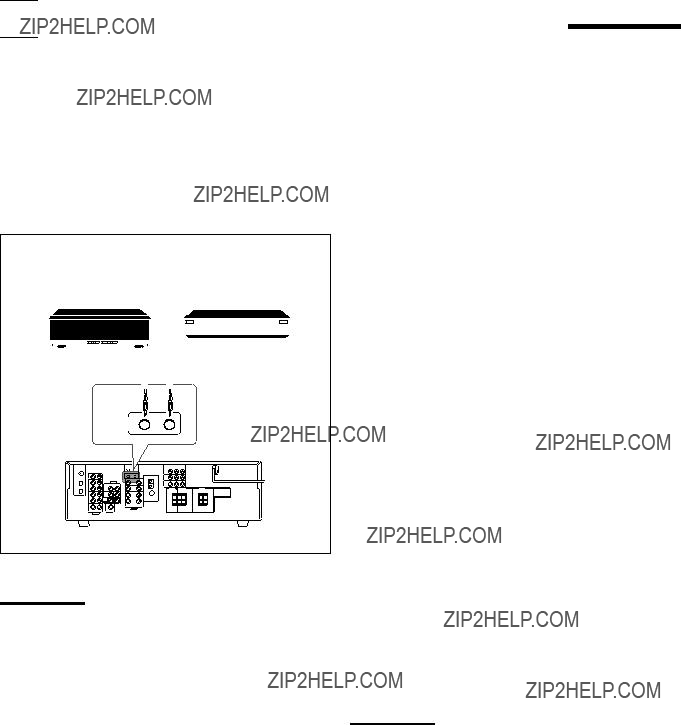

 COMPU LINK Remote Control System
COMPU LINK Remote Control System
The COMPU LINK remote control system allows you to operate JVC???s audio components through the remote sensor on the receiver.
To use this remote control system, you need to connect JVC???s audio components through the COMPU LINK (SYNCHRO) jacks using the cables with monaural
???Make sure that the AC power cords of these components are unplugged before connection. Plug the AC power cords only after all connections are complete.
COMPU
Notes:
???There are four versions of COMPU LINK remote control system. This receiver is equipped with the fourth
This version is added systematic operations with the CD recorder to the previous
???If your audio component has two COMPU LINK jacks, you can use either one. If it has only one COMPU LINK jack, connect it so that it is the last item in the series of components.
???To operate the cassette deck or CD recorder using the COMPU
LINK remote control system, set the source name correctly if required. (See page 14.)
???Refer also to the manuals supplied with your audio components.
This remote control system allows you to use four functions listed below.
Automatic Source Selection
When you press the play (3) button on a connected component or on its own remote control, the receiver automatically turns on and changes the source to the component. On the other hand, if you select a new source on the receiver or on the remote control, the selected component begins playing immediately.
In both cases, the previously selected source continues playing without sound for a few seconds.
Automatic Power On/Off
The connected components turn on and off (standby) along with the receiver.
When you turn on the receiver, one of the connected components will turn on automatically, depending on which component has been previously selected.
When you turn off the receiver, the connected components will turn off (standby).
Synchronized Recording
Synchronized recording means the cassette deck starts recording as soon as a CD begins playing.
To use synchronized recording, follow these steps:
1Put a tape in the cassette deck, and a disc in the CD player.
2Press the record (??) button and the pause (8)
button on the cassette deck at the same time.
This puts the cassette deck into recording pause.
If you do not press the record (??) button and pause (8) button at the same time, the synchronized recording feature will not operate.
3 Press the play (3) button on the CD player.
The source changes on the receiver, and as soon as play starts, the cassette deck starts recording. When the play ends, the cassette deck enters recording pause, and stops about 4 seconds later.
Notes:
???During synchronized recording, the selected source cannot be changed.
???If the power of any component is shut off during synchronized recording, the COMPU LINK remote control system may not operate properly. In this case, you must start again from the beginning.
Remote Control through the Remote Sensor on the Receiver
You can control the connected audio components through the remote sensor on the receiver using this remote control. Aim the remote control directly at the remote sensor on the receiver. For details, see pages 33 and 34.
30


 AV COMPU LINK Remote Control System
AV COMPU LINK Remote Control System
The AV COMPU LINK remote control system allows you to operate JVC???s video components (TV, VCR, and DVD player) through the receiver.
To use this remote control system, connect the video components you want to operate, following the diagrams below and the procedure on the next page.
CONNECTIONS 1: AV COMPU LINK Connection
AV
COMPU LINK ??? III
AV
COMPU LINK
VHS
CAUTION:
You can only connect to the TV with the AV COMPU LINK EX or AV COMPU
DO NOT connect to the TV with AV COMPU LINK RECEIVER/AMP jack.
Notes:
???For
???Make sure that the remote control code for the connected VCR is set to code ???A.???
???When connecting only the VCR or DVD player to the receiver, connect it directly to the receiver using cables with the monaural
CONNECTIONS 2: Video Cable Connection
Connect the VCR and/or DVD player to the TV using one of the following methods:
???For
31

AV COMPU LINK Remote Control System
Connecting procedure
1If you have already plugged your VCR, DVD player, TV and this receiver into the AC outlets, unplug their AC power cords first.
2Connect your VCR, DVD player, TV and this receiver, using the cables with the monaural mini- plugs (not supplied).
???See ???CONNECTIONS 1??? on the previous page.
3Connect the audio input/output jacks on VCR, DVD player, TV and this receiver using the cables with RCA pin plugs.
???See pages 8 and 9.
4Connect the video input/output jacks on VCR, DVD player, TV and this receiver, using the cables with RCA pin plugs (or
???See ???CONNECTIONS 2??? on the previous page.
5Plug the AC power cords of the components and the receiver into the AC outlets.
6When turning on the TV for the first time after the AV COMPU LINK connection, turn the TV volume to the minimum using the TV volume control on the TV.
7Turn on the connected components first, then turn on this receiver.
???When turning on the VCR, use the remote control supplied with this receiver.
The AV COMPU LINK remote control system allows you to use the five basic functions listed below.
Remote Control of the TV, DVD Player, and VCR Using This Remote Control
See page 34 for details.
???Aim the remote control directly at the remote sensor on each target component.
Simply by inserting a video cassette without its safety tab into the VCR, you can enjoy the video playback without setting other switches manually. The receiver automatically turns on and changes the source to the VCR.
The TV automatically turns on and changes the input mode to the appropriate position so that you can view the playback picture. When you insert a video cassette with its safety tab, press the play (3) button on the VCR or on the remote control. So, you can get the same result.
Simply by starting playback on the DVD player, you can enjoy the DVD playback without setting other switches manually. The receiver automatically turns on and changes the source to the DVD player.
The TV automatically turns on and changes the input mode to the appropriate position so that you can view the playback picture.
Automatic Selection of TV???s Input Mode
???When you select the TV as the source to play on the receiver, the TV automatically changes the input mode to the TV tuner so that you can watch TV.
???When you select the DVD player or the VCR as the source to play on the receiver, the TV automatically changes the input mode to the appropriate position so that you can view the playback picture.
Note:
This function does not work when you connect this receiver and the TV with the AV COMPU LINK EX jack using a component video cable. In this case, reconnect the TV referring to CASE 1 or CASE 2 on page 31.
Automatic Power On/Off (Standby)
The TV, VCR, and DVD player turn on and off along with the receiver.
When you turn on the receiver;
???If the previously selected source is the VCR, the TV and VCR will turn on automatically.
???If the previously selected source is the DVD player, the TV and DVD player will turn on automatically.
???If the previously selected source is the TV, only the TV will turn on automatically.
When you turn off the receiver, the TV, VCR and the DVD player will turn off (standby).
Note:
If you turn off the receiver while recording on the VCR, the VCR will not turn off, but continue recording.
32


 Operating JVC???s Audio/Video Components
Operating JVC???s Audio/Video Components
You can operate JVC???s audio and video components with this receiver???s remote control, since control signals for JVC???s components are preset in the remote control.
Operating Audio Components
IMPORTANT:
To operate JVC???s audio components using the supplied remote control:
???You need to connect JVC???s audio components through the COMPU LINK (SYNCHRO) jacks (see page 30) in addition to the connections using cables with RCA pin plugs (see page 7).
???Aim the remote control directly at the remote sensor on the receiver.
???If you use the buttons on the front panel to choose a source, the remote control will not operate that source. To operate a source with the remote control, the source must be selected using source selection buttons on the remote control.
???To operate the target component using the COMPU LINK remote control system, set the source name correctly if required. (See page 14.)
???Refer also to the manuals supplied with your components.
Sound control section (Amplifier)
You can always perform the following operations:
After pressing SOUND, you can perform the following operations by using the 10 keys:
FRONT L then LEVEL
FRONT R then LEVEL
CENTER then LEVEL
SURR L then LEVEL
SURR R then LEVEL
SUBWFR then LEVEL
Note:
After adjusting sounds, press the corresponding source selection button to operate your target source by using the 10 keys; otherwise, the 10 keys cannot be used for operating your target source.
Tuner
You can always perform the following operations:
FM/AM: Alternate between FM and AM.
After pressing FM/AM, you can perform the following operations on a tuner:
1 ??? 10, +10: Select a preset channel number directly. For channel number 5, press 5.
For channel number 15, press +10, then 5. For channel number 20, press +10, then 10.
FM MODE: Change the FM reception mode.
CD player
After pressing CD, you can perform the following operations on a CD player:
1 ??? 10, +10: Select a track number directly. For track number 5, press 5.
For track number 15, press +10, then 5. For track number 20, press +10, then 10.
For track number 30, press +10, +10, then 10.
CD changer
After pressing
After pressing CD, you can perform the following operations on a CD changer:
1 ??? 10, +10: Select a track number directly. For track number 5, press 5.
For track number 15, press +10, then 5. For track number 20, press +10, then 10.
For track number 30, press +10, +10, then 10.
Example:
???Selecting disc number 4, track number 12, and starting playback.
1 Press
2 Press CD, then press +10, 2.
Continued on the next page
33

Operating JVC???s Audio/Video Components
If your CD changer is of
1Select a disc number.
2Then select a track number (always enter two digits).
3Press 3 to start playback.
Examples:
???Selecting disc number 3, track number 2, and starting playback. Press 3, then, 0, 2, then 3.
???Selecting disc number 10, track number 5, and starting playback. Press 1, 0, then, 0, 5, then 3.
???Selecting disc number 105, track number 12, and starting playback.
Press 1, 0, 5, then 1, 2, then 3.
Note:
It is required to press each button within 4 seconds in the above procedure.
CD recorder
After pressing TAPE/CDR, you can perform the following operations on a CD recorder:
VCR
You can always perform the following operations:
After pressing VCR, you can perform the following operations on the VCR:
FF:
REC PAUSE: Enter recording pause.
To start recording, press this button then 3.
DVD player
You can always perform the following operation:
STANDBY/ON  DVD: Turn on or off the DVD player.
DVD: Turn on or off the DVD player.
After pressing DVD (or DVD MULTI for
3: Start playing.
4: Return to the beginning of the current (or previous) chapter.
??: Skip to the beginning of the next chapter.
7: Stop playing.
8: Pause playing. To resume, press 3.
REC PAUSE: Enter recording pause.
To start recording, press this button then 3.
Cassette deck
After pressing TAPE/CDR, you can perform the following operations on a cassette deck:
After pressing DVD (or DVD MULTI), these buttons can be used for the DVD menu operations.
Note:
For detailed menu operations, refer to
the instructions supplied with the discs
or the DVD player.
2
MENU
7/P 8
ENTER
10
Operating Video Components
IMPORTANT:
To operate JVC???s video components using the supplied remote control:
???You need to connect JVC???s video components through the AV COMPU LINK jacks (see page 31) in addition to the connections using cables with RCA pin plugs (see pages 8 and 9).
???Some JVC???s VCRs can accept two types of the control signals??? remote code ???A??? and ???B.??? Before using this remote control, make sure that the remote control code of the target VCR is set to code
???A.???
???When using the remote control, aim the remote control directly at the remote sensor on each component, not on the receiver.
TV
For
You can always perform the following operations:
STANDBY/ON  TV/CATV
TV/CATV
(or STANDBY/ON  TV for
TV for
Turn on or off the TV.
TV/CATV CH +/??? (or TV CH +/??? for
Change the channels. TV VOLUME
TV/VIDEO:Set the input mode (either TV or VIDEO).
After pressing TV SOUND, you can perform the following operations on the TV:
1 ??? 9, 0, 100+ (+10): Select the channels.
RETURN (10): Alternate between the previously selected channel and the current channel.
34



 Operating Other Manufacturers??? Video Equipment
Operating Other Manufacturers??? Video Equipment
[Only for
This remote control supplied for the receiver can transmit control signals for other manufacturers??? TVs, CATV converters, VCRs and DVD players.
When operating the other manufacturers??? components, refer also to the manuals supplied with them.
???After replacing batteries for the remote control, you need to set the manufactures??? codes again.
To change the transmittable signals for operating another manufacturer???s TV
1Set the TV/CATV selector to ???TV.???
2Press and hold STANDBY/ON  TV/CATV.
TV/CATV.
3Press TV SOUND.
4Enter a manufacturer???s code using buttons 1 ??? 9, and 0.
* ???01??? is the initial setting.
5 Release STANDBY/ON  TV/CATV.
TV/CATV.
Now you can perform the following operations on the TV:
STANDBY/ON  TV/CATV: Turn on and off the TV.
TV/CATV: Turn on and off the TV.
TV/CATV CH
TV VOLUME
TV/VIDEO: Set the input mode (either TV or VIDEO).
After pressing TV SOUND, you can perform the following operations on the TV:
1 ??? 9, 0, 100+ (+10):
Select the channels.
The 10 (ENTER) button will function as the
ENTER button if your TV requires pressing
ENTER after selecting a channel number.
Notes:
???All the functions listed above may not be assigned to the buttons for some TVs.
???If you cannot change the channels of some TVs by pressing the 10 keys, press TV/CATV CH +/??? for changing the channels.
To change the transmittable signals for operating a CATV converter
1Set the TV/CATV selector to ???CATV.???
2Press and hold STANDBY/ON  TV/CATV.
TV/CATV.
3Press TV SOUND.
4Enter a manufacturer???s code using buttons 1 ??? 9, and 0.
* ???01??? is the initial setting.
5 Release STANDBY/ON  TV/CATV.
TV/CATV.
Now you can perform the following operations on the CATV converter:
STANDBY/ON  TV/CATV:
TV/CATV:
Turn on and off the CATV converter. TV/CATV CH
After pressing TV SOUND, you can perform the following operations on the CATV converter:
1 ??? 9, 0, 100+ (+10):
Select the channels.
The 10 (ENTER) button will function as the ENTER button if your CATV converter requires pressing ENTER after selecting a channel number.
6 Try to operate your CATV converter by pressing
STANDBY/ON  TV/CATV.
TV/CATV.
When your CATV converter on or off, you have entered the correct code.
If there are more than one code listed for your brand of CATV converter, try each one until the correct one is entered.
6 Try to operate your TV by pressing
STANDBY/ON  TV/CATV.
TV/CATV.
When your TV turns on or off, you have entered the correct code.
If there are more than one code listed for your brand of TV,
try each one until the correct one is entered.
Manufacturers??? codes are subject to change without notice. If they are changed, this remote control cannot operate the equipment.
35

Operating Other Manufacturers??? Video Equipment (Only for
To change the transmittable signals for operating another manufacturer???s VCR
1Press and hold STANDBY/ON  VCR.
VCR.
2Press VCR.
3Enter a manufacturer???s code using buttons 1 ??? 9, and 0.
* ???01??? is the initial setting.
4 Release STANDBY/ON  VCR.
VCR.
Now you can perform the following operations on the VCR:
After pressing VCR, you can perform the following operations on the VCR:
To change the transmittable signals for operating another manufacturer???s DVD player
1Press and hold STANDBY/ON  DVD.
DVD.
2Press DVD.
3Enter a manufacturer???s code using buttons 1 ??? 9, and 0.
* ???01??? is the initial setting.
4 Release STANDBY/ON  DVD.
DVD.
Now you can perform the following operations on the DVD player:
STANDBY/ON  DVD: Turn on and off the DVD player.
DVD: Turn on and off the DVD player.
After pressing DVD or DVD MULTI, you can perform the following operations on the DVD player:
3: Start playing.
4: Return to the beginning of the current (or previous) chapter (or fast reverse for some models).
??: Skip to the beginning of the next chapter (or fast forward for some models).
7: Stop playing.
8: Pause playing. To resume, press 3.
FF:
7:Stop playing or recording.
8:Pause playing. To resume, press 3.
REC PAUSE: Enter recording pause.
To start recording, press this button then 3.
5 Try to operate your VCR by pressing
STANDBY/ON  VCR.
VCR.
After pressing DVD (or DVD MULTI), these buttons can be used for the DVD menu operations.
Note:
For detailed menu operations, refer to
the instructions supplied with the discs or the DVD player.
2
MENU
7/P 8
ENTER
10
When your VCR turns on or off, you have entered the correct code.
If there are more than one code listed for your brand of
VCR, try each one until the correct one is entered.
5 Try to operate your DVD player by pressing
STANDBY/ON  DVD.
DVD.
When your DVD player turns on or off, you have entered the correct code.
Manufacturers??? codes are subject to change without notice. If they are changed, this remote control cannot operate the equipment.
36
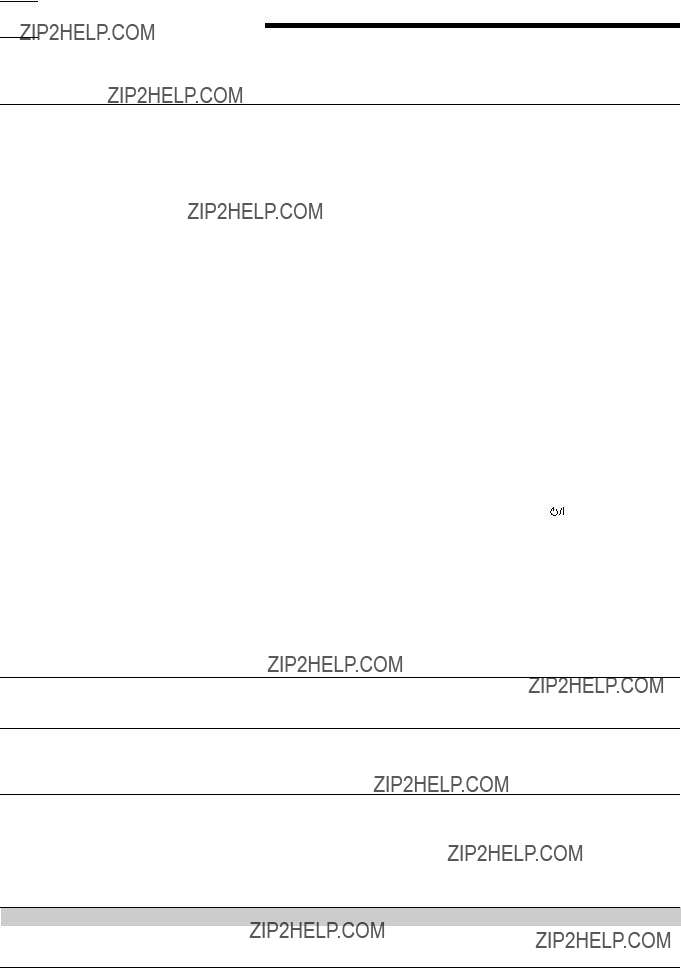

 Troubleshooting
Troubleshooting
Use this chart to help you solve daily operational problems. If there is any problem you cannot solve, contact your JVC???s service center.
Speakers are overloaded because of short circuit of speaker terminals.
Press STANDBY/ON  on the front panel to turn off the receiver, then check the speaker wiring.
on the front panel to turn off the receiver, then check the speaker wiring.
If ???OVERLOAD??? does not disappear, unplug the AC power cord, then plug it back again.
If speaker wiring is not
???DSP NG??? appears on the display.
The
Press STANDBY/ON  on the front panel to turn off the receiver. After unplugging the AC power cord, contact your dealer.
on the front panel to turn off the receiver. After unplugging the AC power cord, contact your dealer.
The STANDBY lamp lights up after turning on the power, and soon the receiver turns off again (into standby mode).
The receiver is overloaded because of a high voltage.
Press STANDBY/ON  on the front panel to turn off the receiver. After unplugging the AC power cord, contact your dealer.
on the front panel to turn off the receiver. After unplugging the AC power cord, contact your dealer.
Remote control does not work.
Remote control does not work as you intend.
An incorrect remote control operation mode is selected.
Select the correct remote control operation mode. (See pages 33 to 36.)
Only for
No sound effect such as Surround and DSP modes.
37


 Specifications
Specifications
*Corresponding to Linear PCM, Dolby Digital, and DTS Digital Surround (with sampling
CD, TAPE/CDR, VCR, TV SOUND, DVD:
Frequency Response (8 ???)
CD, TAPE/CDR, VCR, TV SOUND, DVD:
Bass
Equalization (5 bands) 63 Hz, 250 Hz, 1 kHz, 4 kHz, 16 kHz:
Video Output Level Composite video
VCR, MONITOR OUT:
VCR, MONITOR OUT(Y: luminance): (C: chrominance, burst):
MONITOR OUT(Y: luminance): (PB, PR):
Synchronization:
220 mV
87 dB/62 dB
20 Hz to 50 kHz (+1 dB,
+3 dB ??1 dB at 100 Hz
??8 dB (in 2 dB steps)
1
1
0.286
1
0.7
1
1
0.286
1
0.7
Negative
45 dB
38

??? The remote control supplied with
39

VICTOR COMPANY OF JAPAN, LIMITED
CONTROL AUDIO/VIDEO RECEIVER